
CHAPTER 24
Managing Trumps
Martina Navratilova says that no matter where she goes she can always make new friends at the bridge table.
There is a story that goes back to the days of playing whist, a forerunner of bridge. Whist was a gambling game, and the rumour was that there were hundreds of players who walked the streets of London, penniless, without food or lodging, because they failed to draw trumps. Apparently the story goes on to say that even the children of these players had to beg for a cup of coffee, all because their parents lost so much money at the gambling table due to their failure to draw trumps. When you first start to play bridge, one piece of advice that is often given is always to draw trumps before you do anything else.
One thing is certain. When you are playing in a suit contract, whether or not to lead trumps at your first opportunity is one of the decisions you have to make. You have several choices. You can lead trumps right away, extracting all of the opponents’ cards in the suit; you can avoid drawing them altogether; you can compromise and play some trumps, then another suit; or, vice-versa, play another suit and then play trumps.
The guideline for drawing trumps does not come from an isolated rule like ‘always draw trumps at your first chance’ or ‘save your trumps until you need them’. Instead, it comes as a result of making your plan. Before we go any further, let’s consider what drawing trumps is all about.
Drawing trumps
Although the trump suit is more powerful than the other suits, and therefore unique, it also resembles the other suits. You go about playing the trump suit in much the same way that you would a side suit. You look for ways of promoting winners, you establish tricks in your long suit, you try finesses.
Usually your side has eight cards or more in the trump suit. If you have an eight-card fit, the opponents, therefore, have five cards in the suit, an odd number. You can expect them to be divided evenly between your opponents’ hands, three on one side and two on the other, or 3–2. You would have to play the trump suit three times in order to get all the opponents’ trump cards. If you have a nine-card fit, the opponents would have four cards, an even number. You expect them to be divided not 2–2 but 3–1. You still expect to have to draw trumps three times to remove the opponents’ trump cards. Of course, there are no guarantees. When you have an eight-card fit, the opponents’ cards could be divided 4–1 or 5–0, although that would be against the odds.
Sometimes, you can draw trumps without giving up the lead to the opponents and sometimes you have to give them the lead. Look at the difference between these two holdings in the trump suit:

In each case you have eight trump cards. In the first example, they are divided 4–4 between your hand and the dummy. If you were going to draw trumps you would have to play the suit three times and would lose the lead three times. In the second example, you would have to play the trumps three times also, but you would not have to give up the lead even once to do so.
There are times when the trump suit is solid, as in the second example above, but, more frequently, your trump tricks have to be established through length as in the first example. You may also have to use the finesse when playing your trump suit. Consider this layout:

You have an eight-card fit and expect the opponents’ cards to be divided 3–2. You plan to play the suit three times to draw all their trumps. You have a winner with the  A. You can also hope to win a trick with the
A. You can also hope to win a trick with the  Q. To finesse against the
Q. To finesse against the  K, lead towards the card you hope will take a trick. Lead from your hand towards the dummy’s
K, lead towards the card you hope will take a trick. Lead from your hand towards the dummy’s  Q.
Q.
Since the advice to draw trumps at your first opportunity is so often given, before we look at the exceptions let’s consider why this advice is so popular. If a player cannot follow suit, a small trump card has more power than an honour card in the side suit led. Because of this, the declarer generally wants to get rid of the opponents’ trump cards so that they will not be used against his winners.
Let’s look at two hands where drawing trumps is a good idea. In the first hand, you are in a contract of 4  . The opening lead is the
. The opening lead is the  K.
K.
Contract: 4
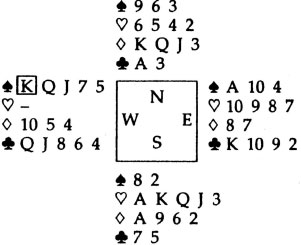
You can afford three losers and have two spade losers and one club loser. When you organize your plan, you want to play the cards in an order that does not put you in a position to create an extra loser. Look at what would happen if you did not draw the trumps. If you were to play diamonds, for example, the third round could be trumped by East – a loser you didn’t count on.
You might think that using two of your trumps to draw out one of the opponents’ trumps is not a good bargain. The alternative, however, is to let East enjoy a winner with one of his hearts. By drawing all his trumps, you prevent this.
Let’s look at another example. This time you are in a part-score contract of 3  . The lead is the
. The lead is the  K.
K.
Contract: 3

This time you can afford four losers and so you aren’t too concerned when the opponents drive out your  A, leaving you with two club losers. You are also missing the
A, leaving you with two club losers. You are also missing the  A and the
A and the  K. You have no losers in either spades or diamonds so you should be able to make the contract. When you organize your plan, don’t create an extra loser for yourself. Where could an extra loser be created? Look at the diamonds. If you try to take three rounds of diamonds before drawing trumps, West will score not only the
K. You have no losers in either spades or diamonds so you should be able to make the contract. When you organize your plan, don’t create an extra loser for yourself. Where could an extra loser be created? Look at the diamonds. If you try to take three rounds of diamonds before drawing trumps, West will score not only the  A and
A and  K but the
K but the  2 as well. To avoid this, draw the trumps, even though you have to give up the lead twice to do this.
2 as well. To avoid this, draw the trumps, even though you have to give up the lead twice to do this.
You don’t mind giving West the trump tricks he has coming to him, the  A and
A and  K, but you want to avoid an unnecessary loser in the trump suit. After winning the
K, but you want to avoid an unnecessary loser in the trump suit. After winning the  A, play a heart. West will win the trick and the defenders can take their club tricks. They might then lead a diamond, which you will win. Lead another heart and again give West the lead. Now what can West do? Whatever he leads, you can win the tricks and draw his remaining trump. Now, you can take your diamond winners in comfort.
A, play a heart. West will win the trick and the defenders can take their club tricks. They might then lead a diamond, which you will win. Lead another heart and again give West the lead. Now what can West do? Whatever he leads, you can win the tricks and draw his remaining trump. Now, you can take your diamond winners in comfort.
It might seem as if the only time you draw trumps is when you have the number of losers you can afford. So as not to leave that impression, let’s look at one more hand where drawing trumps is a priority. You are in a part-score contract of 3  with the opening lead of the
with the opening lead of the  Q.
Q.
Contract: 3
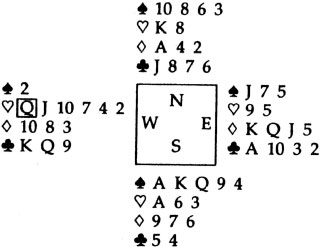
You can afford four losers in your 3  contract. You have no spade losers, one heart loser, two diamond losers and two club losers. You need to get rid of one loser. Look for unevenly divided suits between your hand and the dummy to see if there is either the opportunity to trump a loser in the dummy or to get rid of a loser on one of the dummy’s winners. When you look at the two hands for opportunities to get rid of losers, you see that there are more hearts in your hand than in the dummy and that there is an opportunity to trump a loser in the dummy. Unlike the first two examples, where you had the number of losers you could afford, this time you have to trump a loser in the dummy.
contract. You have no spade losers, one heart loser, two diamond losers and two club losers. You need to get rid of one loser. Look for unevenly divided suits between your hand and the dummy to see if there is either the opportunity to trump a loser in the dummy or to get rid of a loser on one of the dummy’s winners. When you look at the two hands for opportunities to get rid of losers, you see that there are more hearts in your hand than in the dummy and that there is an opportunity to trump a loser in the dummy. Unlike the first two examples, where you had the number of losers you could afford, this time you have to trump a loser in the dummy.
Does it matter whether you draw trumps first or trump a heart in the dummy first? Look at ail four hands. If you try to trump a heart before getting rid of the trumps in the opponents’ hands, East will be able to overtrump anything you can contribute in the dummy with his  J. You only need one trump to get rid of your heart loser. You do not have to give up the lead to draw trumps. Therefore, the best plan is to draw the trumps and then get rid of your loser.
J. You only need one trump to get rid of your heart loser. You do not have to give up the lead to draw trumps. Therefore, the best plan is to draw the trumps and then get rid of your loser.
You cannot conclude that it is always the best idea to draw trumps before you go about trumping losers in the dummy. Each hand is different and you have to look at it in the context of your plan. As we have seen in previous chapters, on many hands where you are going to trump a loser in the dummy, you cannot afford to draw the trumps. How can you know when playing trumps is right? Make your plan and use it to look ahead a few tricks. In the hand we just looked at, you knew you needed only one trump left in the dummy to take care of the heart loser in your hand, and you had four trumps. You could also see that drawing trumps would not give up the lead. You still had control of the hand. In this situation you had nothing to lose by drawing trumps before trumping your loser. The opponents could not get the lead and interrupt your plan.
Delaying drawing trumps
Let’s look at two situations where you should delay drawing trumps. Remember, the reason you count losers when you are in a trump contract is that you have the opportunity, because of the power of the trumps, to get rid of those losers. You can either trump them in the dummy or you can throw away losers from your hand on the extra strength in the dummy. Both ways of getting rid of losers are closely connected to the trump suit.
First, if you are going to trump losers in the dummy, you have to make sure you have enough trumps in the dummy to do the job. In the last hand, we could comfortably draw trumps and still have a trump in dummy to take care of our loser. But that is not always, or normally, the case. More often, you have to guard your trumps carefully.
There is another important aspect of managing your trumps so that you have enough in the dummy to take care of the declarer’s losers, and that is to remember that you have opponents. You are not the only player at the table who can draw trumps. You have first to decide how many trumps in the dummy you are going to need to take care of the losers in your hand. Then you have to consider how many times you have to give up the lead to the opponents before you are in a position to trump your losers. Before you go about drawing even a single round of trumps, consider what will happen if your opponents draw them for you. Let’s look at a hand. You are in a contract of 2  and the opening lead is the
and the opening lead is the  3.
3.
Contract: 2

You can afford five losers but it looks as if you have six: one spade, three hearts and two clubs. You have to get rid of one loser. What are the possibilities? You can’t get rid of a spade loser since there are fewer cards in your hand than in the dummy and there is no extra strength in the suit in the dummy. The heart suit, if you look closely, has the right pattern to trump a loser in the dummy. You have three hearts in your hand and only two in the dummy. You need only one trump to take care of your heart loser and so you have to manage your trumps so that there is one left in the dummy.
The next observation to make is that you have to give the opponents the lead twice before you are in a position to trump your loser in the dummy. That means that the opponents could draw your trumps twice, leaving you with only one in the dummy. That you can afford. But, if you also draw a round of trumps, then you will be left with no diamonds to trump your losing heart trick and will be left with your original six losers. One occasion to avoid drawing trumps, then, is when you need to keep your trumps in the dummy to take care of a loser or losers in your hand.
The second way of getting rid of an extra loser is to throw it on one of the dummy’s strong side suits. Should you draw the trumps before you do this? After all, you are not really counting on the dummy’s trumps this time.
One consideration here is whether drawing the trumps would give up the lead. When you have to get rid of a loser, you may have to do it quickly, before you give the opponents the lead, because once they get in they might be able to take enough tricks to defeat the contract.
This is best seen by looking at a complete hand. The contract is 4  and the opening lead is the
and the opening lead is the  Q.
Q.
Contract: 4
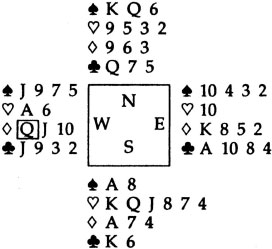
You can afford three losers. You have no spade losers, one heart loser, two diamond losers and one club loser, one too many. You need to get rid of one of your losers. Is there the opportunity to do this? Look for your unevenly divided side suits. There are more spades in the dummy than there are in your hand so this suit offers a good opportunity to get rid of a loser from your hand. A closer look shows that it is an excellent opportunity, since you have the first three tricks in the suit.
Are you going to draw the trumps before you try to get rid of your loser in the spade suit? Look ahead. What would happen if you started to draw the trumps? The opponents could take a trick with the  A. Now what would you expect them to do? They would take their two diamond winners and would probably be able to figure out to take the
A. Now what would you expect them to do? They would take their two diamond winners and would probably be able to figure out to take the  A. You would have lost four tricks and would be defeated in your contract of 4
A. You would have lost four tricks and would be defeated in your contract of 4  .
.
You cannot give up the lead to the opponents before you get rid of a loser. So, suppose that instead of drawing trumps after you win the first trick with the  A, you play the spades and throw a diamond loser on the third round. Then you draw the trumps. Again, the opponents get the lead and try to take two diamond tricks. However, since you threw a diamond away, you can trump on the third round. You are successful in holding yourself to only three losers, enough to make the contract.
A, you play the spades and throw a diamond loser on the third round. Then you draw the trumps. Again, the opponents get the lead and try to take two diamond tricks. However, since you threw a diamond away, you can trump on the third round. You are successful in holding yourself to only three losers, enough to make the contract.
Summary
It is generally a good idea to draw the opponents’ trumps as quickly as possible to prevent the opponents from playing a trump on one of your winners. Draw trumps in the following situations:
• When you have the winners you can afford – even if you have to give up the lead a couple of times in the process.
• When you don’t have enough tricks but you don’t have to give up the lead, and don’t need all your trumps to trump losers in the dummy.
Delay drawing trumps in two situations:
• When you are going to need trumps in the dummy to take care of one or more losers in your hand, and you will not have enough left if you, or the opponents, draw trumps.
• When you would have to give up the lead to the opponents by drawing trumps and they can then take enough tricks to defeat your contract.
Over Zia’s shoulder
Hand 1 Dealer: East
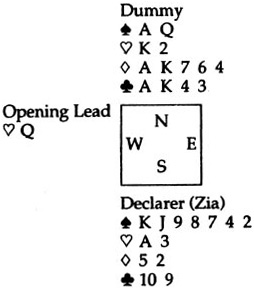
|
N |
E |
S (Zia) |
W |
|
Pass |
3 |
Pass |
|
|
4NT |
Pass |
5 |
Pass |
|
7 |
Pass |
Pass |
Pass |
Our first hand in this chapter is a grand slam. It seems easy enough, doesn’t it? This hand will be fun to play together.
Solution to Hand 1:
Contract: 7

|
S |
We can afford no losers. |
|
T |
We have no losers in spades, hearts, diamonds or clubs. That’s good news. |
|
O |
Where could extra losers come from? Well, there is a possibility that if we don’t draw the opponents’ trump cards we could have an unexpected loser. This hand seems straightforward enough. There is one careless mistake we could make. Suppose we take the first heart trick with the |
|
P |
Instead, we have to play the |
Hand 2 Dealer: South
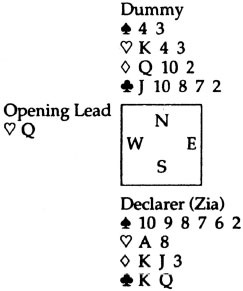
|
N |
E |
S (Zia) |
W |
|
1 |
Pass |
||
|
1NT |
Pass |
2 |
Pass |
|
Pass |
Pass |
When you first look at this hand there seems to be too much to do. Where do we start?
Solution to Hand 2:
Contract: 2

|
S |
We can afford five losers. |
|
T |
Our loser count tells us that we have at least three spade losers – assuming they are divided 3–2 – one diamond loser and one club loser. |
|
O |
We can afford five losers. Are there any dangers in the hand? Yes. If we don’t start by getting the opponents’ trumps out of the way we are liable to find that they use their high trumps separately. We have enough length in the trumps not to worry. There is nothing to ruff in the dummy so we have no reason to delay drawing the trumps, even if it means giving them the lead three times. |
|
P |
So, we win the first heart trick and immediately lead a trump. When we next get the lead, we lead another trump. Once all their trumps are gone, we have no more worries. If we didn’t decide on this plan, they will probably get an extra trick in the trump suit, which they don’t deserve. |
Hand 3 Dealer: South

|
N |
E |
S (Zia) |
W |
|
1 |
Pass |
||
|
1NT |
Pass |
3 |
Pass |
|
4 |
Pass |
Pass |
Pass |
It is annoying, but West has again found the best lead. On any other lead we would be waltzing. Well, never say die.
Solution to Hand 3:
Contract: 4
|
S |
We can afford three losers. |
|
T |
It looks as if there is a spade loser, two diamond losers and a club loser. We have to get rid of one. |
|
O |
Normally, in a suit contract, we like to go after the trumps as soon as possible. That is a pretty useful guideline, but only when there is no more urgent job. Here, if we win the diamond lead and start our trumps, the nasty opponents – opponents are nearly always nasty! – might take two diamond tricks and the |
|
P |
After winning the |